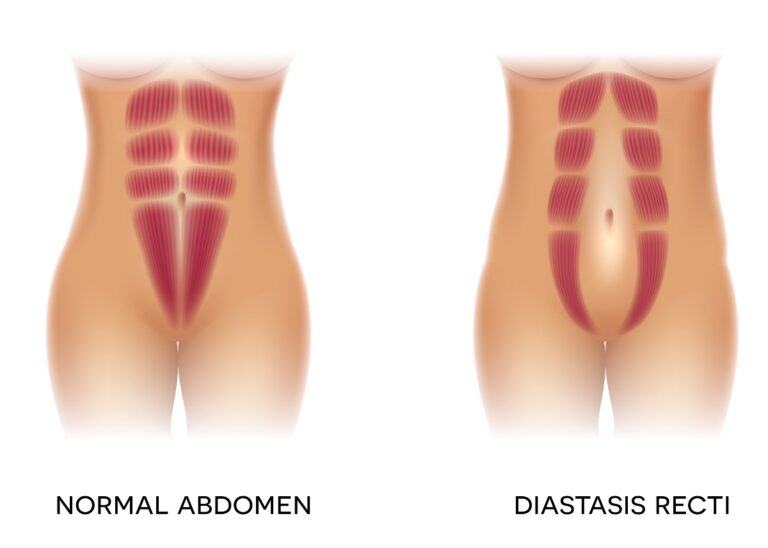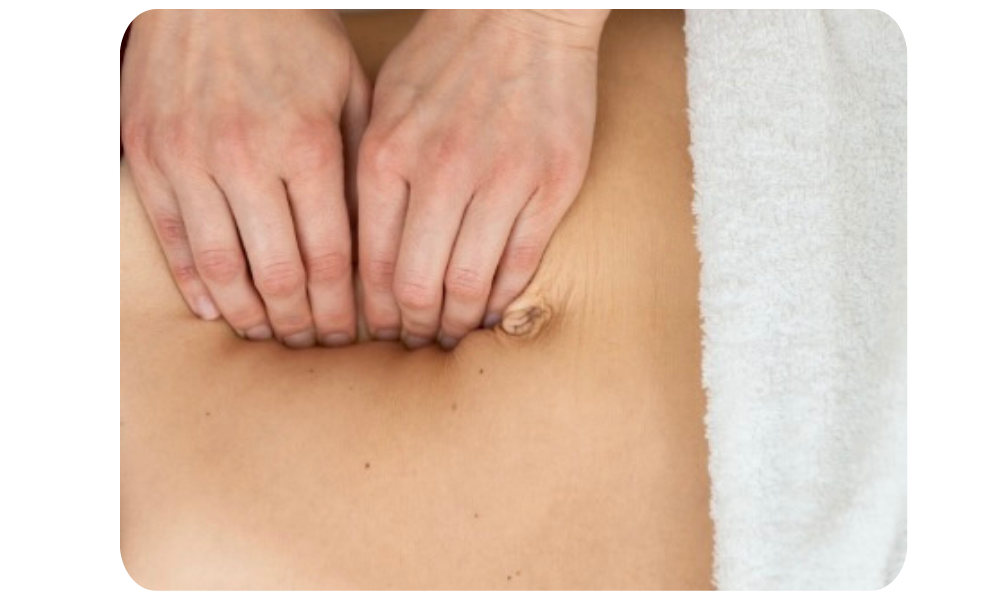Rectus diastasis, also known as diastasis recti, occurs when the connective tissue between the left and right sides of the abdominal muscles stretches, creating a gap. This separation is most commonly seen in postpartum women but can affect men and children too, especially if they’ve had significant weight changes.

Incident Rate of Rectus Diastasis
Rectus diastasis is quite common, with studies showing that about 60% of women experience it during or after pregnancy. The risk increases for those who have had multiple pregnancies, carry larger babies, or had rapid abdominal changes. Though it often improves on its own postpartum, some women may continue to experience the condition beyond six months, leading to long-term challenges with core strength, posture, and even back pain.
Don’t know if you have Diastasis Recti? Use this guide to check for yourself!
What Causes Delayed Healing?
While many women recover naturally from rectus diastasis within the first 8 weeks postpartum, several factors can contribute to delayed healing:
- Excessive intra-abdominal pressure: Straining, lifting heavy objects, or poor exercise techniques can prevent the gap from closing.
- Lack of core engagement: Not activating the deep abdominal muscles (transverse abdominis) can hinder recovery.
- Improper posture and alignment: Slouching or improper body mechanics during daily activities can put extra strain on the abdominal wall.
- Connective tissue quality: In some cases, the degree of connective tissue damage or weakness may be more severe, requiring additional time and therapeutic intervention for healing.
The Latest Research on Rectus Diastasis
Recent research has shed new light on the complexities of rectus diastasis and its long-term impacts. Studies now suggest that rectus diastasis is not merely a cosmetic issue but can also contribute to functional impairments such as:
- Impaired core stability: Incomplete healing can lead to issues like lower back pain, pelvic floor dysfunction, and even urinary incontinence .
- Long-term impact on movement patterns: Untreated rectus diastasis can cause compensatory movement patterns that strain other parts of the body, leading to secondary injuries such as hip or shoulder pain .
- Exercise as the key to recovery: A growing body of evidence supports therapeutic exercise as the most effective treatment for diastasis recti, particularly programs focused on engaging the transverse abdominis and pelvic floor muscles. Surgical intervention is typically considered a last resort when functional issues persist despite conservative treatment.
How to Prevent Rectus Diastasis
The best way to prevent rectus diastasis is by maintaining proper core strength before, during, and after pregnancy. Here are some tips to lower your risk:
- Strengthen your core: Focus on deep core exercises that engage the transverse abdominis. These muscles act as your internal corset and support the abdominal wall.
- Maintain good posture: Avoid slouching, especially during pregnancy. Keep your spine aligned, and use supportive seating when necessary. In addition, try to avoid excessive lumbar lordosis, an increased curvature in the lower back making it difficult to keep “the baby in the basket” posturally.
- Avoid heavy lifting: If you must lift, make sure you engage your core by bracing your abdominal muscles like you are ready to sneeze or saying “shhh” forcefully.
- Use proper body mechanics: Practice squatting rather than bending from the waist when picking up items, and avoid exercises that increase intra-abdominal pressure, like sit-ups or crunches, during pregnancy. Don’t forget to exhale as you lift and come up from a squatting position to help manage your intraabdominal pressure.
Best Exercises to Help Heal Rectus Diastasis
Exercise can play a significant role in helping close the abdominal gap, but it’s important to perform the right movements:
- Pelvic tilts: This simple movement can help re-engage your core muscles without straining your abdominal wall.
- Heel slides: While lying on your back, slowly slide one heel out while keeping your core engaged. This is a gentle way to activate your abdominal muscles.
- Diaphragmatic breathing: Yes we want to restore belly breathing but we don’t stop there. The goal is to breathe 360 degrees to make sure we “spread” the pressure. Many times there is tightness in the lower back causing the “air” to go to the area of least resistance which is the front of the abdominal wall.
- Kegels: Pelvic floor exercises like Kegels support core strength and work in conjunction with the abdominals to create stability. For some however have tightness in their pelvic floor and need lengthening not strengthening their pelvic floor.
- Modified planks: Once you’ve developed a strong connection with your deep core muscles, you can begin incorporating modified planks or wall planks to further strengthen your core.
Why It’s Important to Work with an Expert
Healing rectus diastasis can be complex and requires the right guidance and approach. Working with an expert, like a physical therapist trained in postpartum recovery or core rehabilitation, is essential for several reasons:
- Personalized care: An expert can assess your specific condition and tailor exercises that are safe and effective based on your healing progress.
- Avoiding further damage: Without the right technique, certain exercises or daily activities can worsen the separation. An expert will ensure you are doing movements that promote healing and avoid harm.
- Long-term recovery: Healing isn’t just about closing the gap. It’s about restoring full function to your core and pelvic floor to prevent future issues like back pain or pelvic instability.
At Soma Vita Physio & Wellness, we specialize in helping individuals heal from rectus diastasis through targeted exercise programs, body mechanics training, and hands-on techniques to facilitate recovery. If you’re struggling with rectus diastasis or want to ensure you’re doing the right things to heal properly, reach out to us for expert care and guidance.




